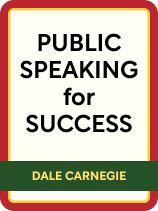

This article is an excerpt from the Shortform book guide to "Public Speaking for Success" by Dale Carnegie. Shortform has the world's best summaries and analyses of books you should be reading.
Like this article? Sign up for a free trial here.
Should you use humor to open a speech? What are some ways to appeal to people’s needs and desires?
Dale Carnegie’s public speaking advice has helped countless people reach their audiences. In Public Speaking for Success, he shares several recommendations for speaking in ways that make people want to hear more.
Continue reading to learn how to get the attention of your audience and keep it throughout your speech.
How to Get the Attention of Your Audience
Carnegie explains that you must hook an audience’s attention right from the start of your speech. People are generally impatient, so you have to grab their attention very quickly. This is best achieved with an opening that you design in advance to maximize your chance of success. Carnegie recommends the following advice for how to get the attention of your audience at the start of your talk:
- Keep it succinct. Refine your opening to a sharp, powerful sentence or two at max. Then charge ahead into your speech.
- Arouse curiosity. People are naturally curious—take advantage of their desire to know more with a shocking statement, novel information, or a captivating question.
- Appeal to self-interest. If your audience is practical or business-oriented, tell them how what you have to say will improve their lives or bottom lines.
- Find common ground. When your topic is contentious, open by tactfully speaking to shared experiences, values, or points of reference between you and the audience. This gives them a positive first impression and ensures they’ll listen to what you have to say.
| Appeal to Core Human Needs to Hook Your Audience For a complementary perspective on how to hook and hold an audience’s attention, we can look to the field of marketing and advertising. For example, in Ca$hvertising, Drew Whitman contends that hooks grab and hold attention by addressing one of eight core human needs: • To live a long and happy life • To eat and drink well • To avoid fear, threats, and danger to your life • To find a sexual partner • To be safe and comfortable • To have status and recognition • To take care of your loved ones • To be accepted by society Since these needs are biologically embedded in all of us, any appeal that addresses one or more of them will make sense and feel important to the audience. This also reduces the amount of extra convincing you’ll need to do if your point is abstract since you’ve linked it to something tangible and meaningful to everyone. |
Beyond what to do, Carnegie says, you can also improve your opening by avoiding the following common (and often ruinous) errors:
- Opening with an apology. Often used to seem humble, this technique makes speakers look incompetent or unprepared and can annoy audiences. (Shortform note: Research confirms that apologizing excessively lowers self-esteem and others’ respect for you.)
- Opening with humor. Most speakers can’t pull off jokes, so you’ll most likely make the audience cringe and pull away emotionally. (Shortform note: If you do use humor, use a self-deprecating joke to humanize yourself—and never say anything offensive or rude.)
- Opening too formally. Scripted, overly rehearsed, and/or dry openings easily lose the audience’s attention. (Shortform note: In contrast, Chris Anderson suggests in TED Talks that a scripted opening works in some situations, like funerals, where formality matters.)
How to Keep the Attention of Your Audience
Once you’ve hooked the audience’s attention, you need to continue to earn it. According to Carnegie, you can do this by paying attention to how you speak and not just what you say. While he states that there are no hard-and-fast rules, Carnegie does recommend these techniques:
- Speak conversationally, as if you’re chatting with a close friend. This will bring out a natural, sincere quality in your voice and help the audience feel connected to you.
- Speak to individuals, not the crowd. After all, the audience is composed of individuals, and people generally appreciate being recognized and spoken to. Make eye contact; create connections.
- Let loose your individuality. Real stage presence comes from an authentic individual owning their personality. To truly own the stage, speak, move, and express yourself in whatever way feels most natural.
Remember also that your attitude influences your audience’s attitude—that is, they respond to the emotion you give off. To avoid appearing uncomfortable or awkward, stand tall and keep your hands relaxed at your sides. Let yourself gesture naturally, but avoid sharp or jerky movements. All in all, practice speaking spontaneously, authentically, and as only you can.
(Shortform note: While Carnegie recommends being natural, authentic, and spontaneous to connect with your audience, in Talk Like TED, Gallo suggests that you should thoroughly rehearse how you’ll stand, move, and act on stage. He suggests that you exude confidence by standing up straight, making frequent eye contact with crowd members, keeping your head high, and staying relaxed rather than fidgeting. To rehearse this all, find a family member or friend and practice “faking it ’til you make it”—even if you don’t feel confident at first, acting confident will gradually improve your body language and delivery.)

———End of Preview———
Like what you just read? Read the rest of the world's best book summary and analysis of Dale Carnegie's "Public Speaking for Success" at Shortform.
Here's what you'll find in our full Public Speaking for Success summary:
- Why public speaking is one of the most important skills to have
- How to overcome the fear of public speaking and adopt poise
- How to research, write, and deliver a memorable speech






